Schiaparelli’s Daniel Roseberry on reimagining the famed French fashion house
American Daniel Roseberry is not daunted by the legacy of the legendary Elsa Schiaparelli as he takes her fabled fashion house into fresh new territory.

Outside the Schiaparelli haute couture show in July, a reality TV star slowly fans her long golden talons for a photographer in too-hot-for-Paris-in-July thigh-high leather boots. The actress Emma Watson flashes past in one of Schiaparelli artistic director Daniel Roseberry’s sculpted shoulder blazers. “Emma! Emma!” the onlookers yell, leaning over the railings. “This is a good-looking crowd,” muses one fashion editor as she scans the line.
In this crowd too, some of them in the house’s gold “toe” shoes, others carrying the best-selling top-handle bag with appliqué protrusions of body parts – a nose, eyes with pearl-encrusted lashes – there is a sense of the tension between beauty and taste, the surreal and the exacting, that 37-year-old Texan Daniel Roseberry has explored since he joined Schiaparelli in 2019 and blew it up.
It is easy to imagine the house’s founder, Elsa Schiaparelli (Schiap as she referred to herself, in the third person) would approve of Roseberry’s interpretation of the fashion house she founded in Paris in 1927. Known for her surreal designs and less so for her flashes of pragmatism (after all, as a single mother she started with smart sweaters for, in her words, “sweater-minded women”), Schiaparelli was perhaps above all, original.
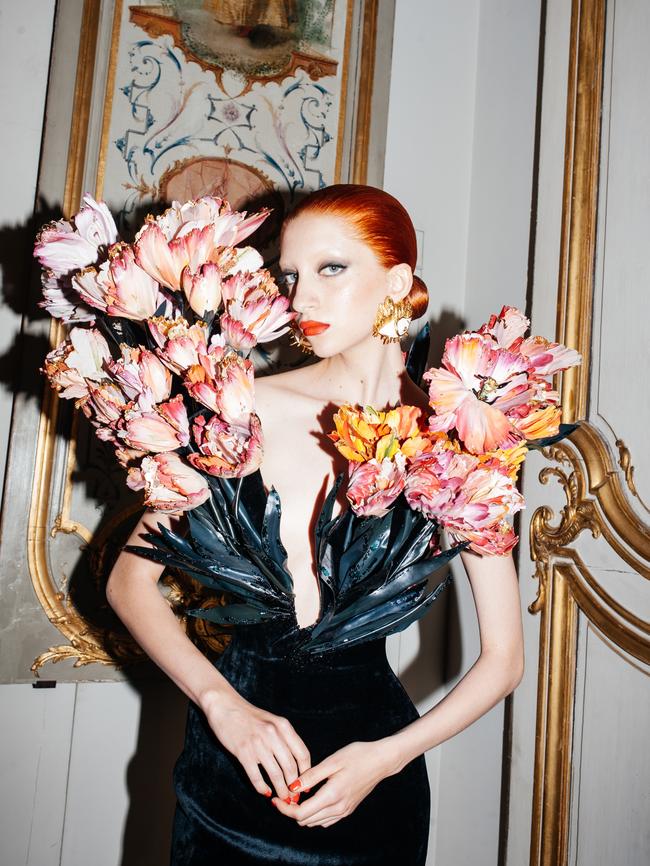
The show, with flowers that bloomed from corsets, was sublime and soaring. The Jurassic Park soundtrack (“life finds a way!”) underscored how Roseberry had been thinking about the integrity of beauty, the dullness of too much self-seriousness and the pull of nostalgia. In the show notes, Roseberry wrote of protecting creative innocence.
The next day in his sunlit office (the same building Schiap once worked in) with a knock-out view of Place Vendôme, Roseberry says that after an haute couture show, “I think you feel really relieved, empty and proud. Every season, it’s really like clawing your way back to a place of creative innocence, because every season you give so much of yourself away. Your team gives so much of themselves away. You have to convince people to get back in the saddle and do it all over again and give it all away again,” he says. “That is part of the disease of the mind that fashion kind of does to you. It’s also incredibly rewarding, and you’re constantly chasing those moments where you can gather 450 people in a row and make them all feel something you think is important.”
Dressed in the blue denim he is often photographed wearing, Roseberry is interesting and interested, thoughtful and direct.

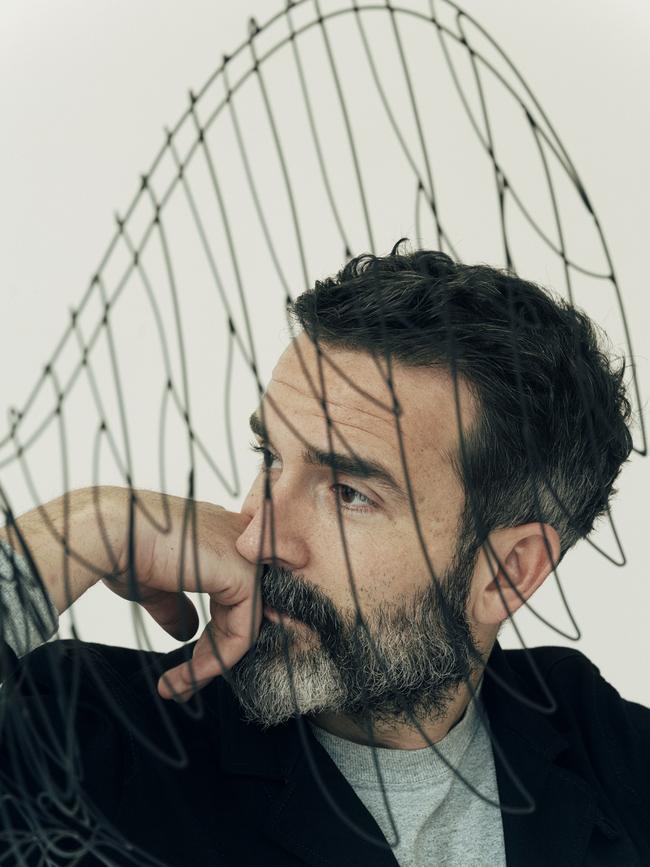
After the haute couture show he went home, took a nap and watched The Empire Strikes Back. “I find that I’m constantly looking for ways of self-soothing, because I think that just being alive today, working today and being exposed to the news and to everything that’s going on, the creative side of my brain I think is crying out for a way of being comforted or being reassured,” he says. “I think that’s also where Jurassic Park came from. It’s this way of reassuring myself in [a] way ... I go back to those movies where times felt simpler. I know that times weren’t simpler then, but I was a child it felt simpler to me because I was less aware.”
It makes sense for Roseberry to seek comfort in simpler times. His ascent these past few years has been wild. To cite just a few accomplishments: he dressed Lady Gaga for Joe Biden’s presidential inauguration and Beyoncé in a gold conical swirl corset for her Renaissance album cover art.
Under Roseberry, Schiaparelli has become the go-to for celebrities who aren’t afraid of getting a little freaky on the red carpet, including model Bella Hadid in her slinky black dress with gold “lungs” at the Cannes Film Festival in 2021 and Kim Kardashian’s “Hulk Green” torso corset. The list includes actress Julia Fox in the white heat of her 15 minutes earlier this year, Carey Mulligan at this year’s Met Gala, and Adele.
Roseberry’s collections entwine the otherworldly with the immaculate tailoring and affinity for elegant American sportswear (yes, denim in haute couture!) that he honed during 11 years as design director of men’s and womenswear at the preppy with an irreverent kink American luxury brand Thom Browne.
In a short time, Roseberry has unpicked Parisian elegance and pop culture and developed new signatures for the house – embellished cone bras and silk faille rosettes, the gold bijoux. He’s just getting started.
“I think I’m learning a lot,” he says.” Every season’s like cutting my teeth in a new technique. I think that’s why for me it’s way too soon to be settling down too much into a certain technique or a certain vocabulary of the collection, like the gold. Okay, we’re going to explore gold this season. Let’s explore it to the limit. The next season it’s like, ‘Okay, let’s do something new like florals.’ We’ve never done florals before. How can we do it in a way that’s extreme, that’s Schiaparelli?”
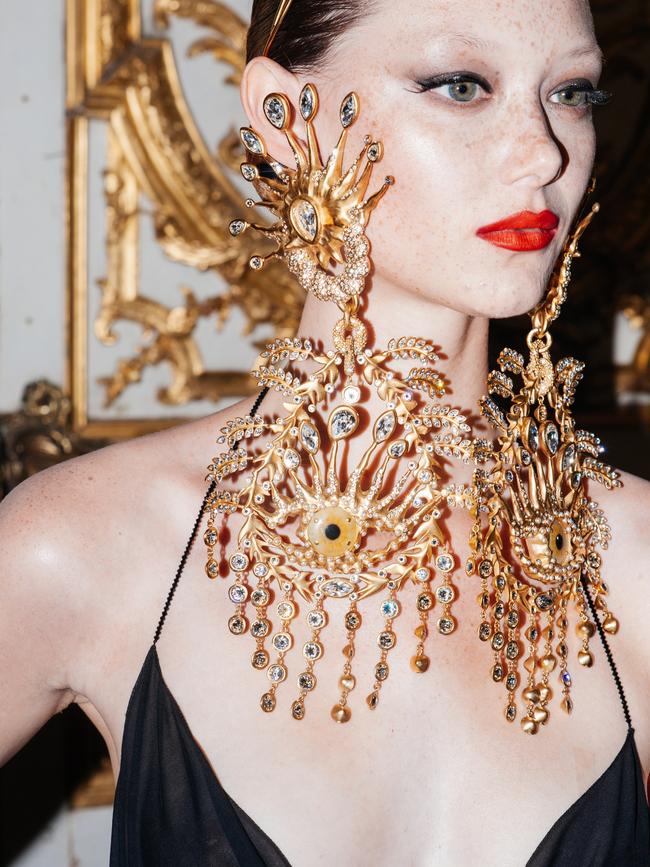
Roseberry says the freedom he is afforded by the brand is rare. He is not the first artistic director to take it since Tod’s chairman Diego Della Valle bought the rights to the dusty house in 2007. Since 2012, when Valle announced his plans to revive Schiaparelli, the roster of artistic directors has included Christian Lacroix, Marco Zanini and Bertrand Guyon.
Every season, says Roseberry, is carte blanche. He loves a beginning and starts with a sketch using a sharpie pen – “I like the gratification of a big bold line,” he says. “The beginning is always so fun because it’s when everything is possible and it’s the blank page … I love being in a house where I have that freedom. I do not [get] a marketing plan at the beginning of the collection that says, ‘These are the kinds of silhouettes we have to have.’ I have a really great dialogue with the sales team, but it’s more like ... ‘Our clients loved this kind of gown or they’re obsessed with the gold, but if we had colour, it would be great.’ ”
The night of the haute couture show was also the opening of Shocking! The Surreal World of Elsa Schiaparelli, a retrospective of the founder and her house at the Musée des Arts Décoratifs in Paris.
Olivier Gabet, then-director of the Musée (in July he moved to the Louvre) says Elsa Schiaparelli’s work has been underrated. Something emphasised by the designers who’ve paid posthumous homage to her, such as John Galliano, Marc Jacobs and Hubert de Givenchy. The exhibition showcases some of her best-known creations, the famous lobster dress (a collaboration between Schiaparelli and Salvador Dali) worn by the infamous Wallis Simpson, Duchess of Windsor, in 1934; the upside-down shoe hat; the “hard chic” jackets; as well as pieces from proponents of the 20th century surrealism movement (which spliced reality with the unconscious self in a reaction to rationalism), such as photographer Man Ray and poet and artist Jean Cocteau. Little wonder that her rival, Gabrielle “Coco” Chanel, was said to have referred to Elsa as “that artist who makes clothes”. The exhibition, which runs until January, includes pieces from Roseberry’s oeuvre and the big celebrity moments. This is something Gabet says is essential for continuing, and contextualising, the story of Schiaparelli.
“In 2022, Elsa’s legacy and vision have a lot to tell us, and we wanted to bring this to a younger audience,” he says. He sees Roseberry’s work, “so spectacular”, as reigniting an appetite for what has been done before, but without looking back.
“Fashion is a paragon of the ephemeral, and [Roseberry’s] creations do not yet suggest the use of a retrospective gaze, but … references made to the history of fashion are visible and allow for a historical reading of his work. The forms the designer explores however, poetically suggest timelessness and history.”
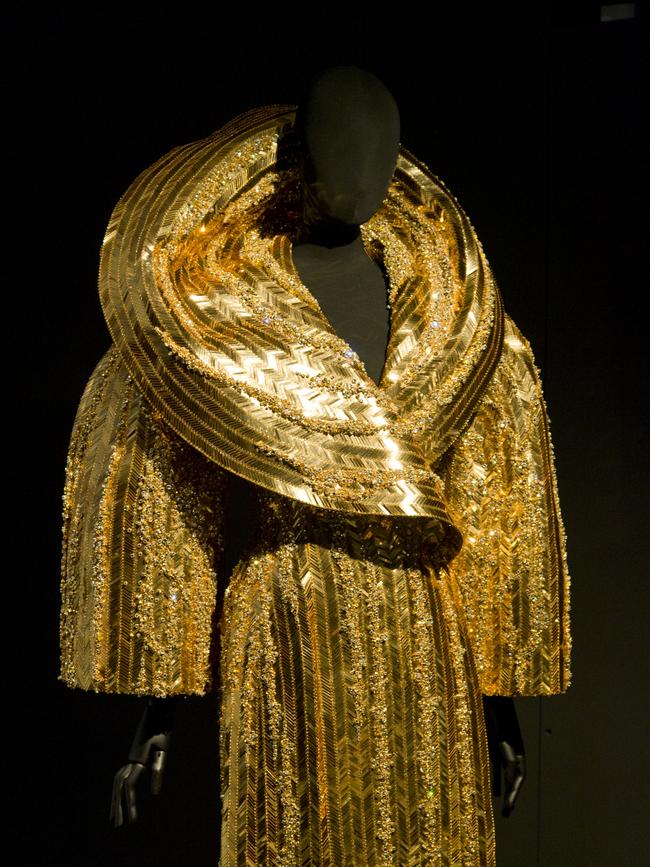
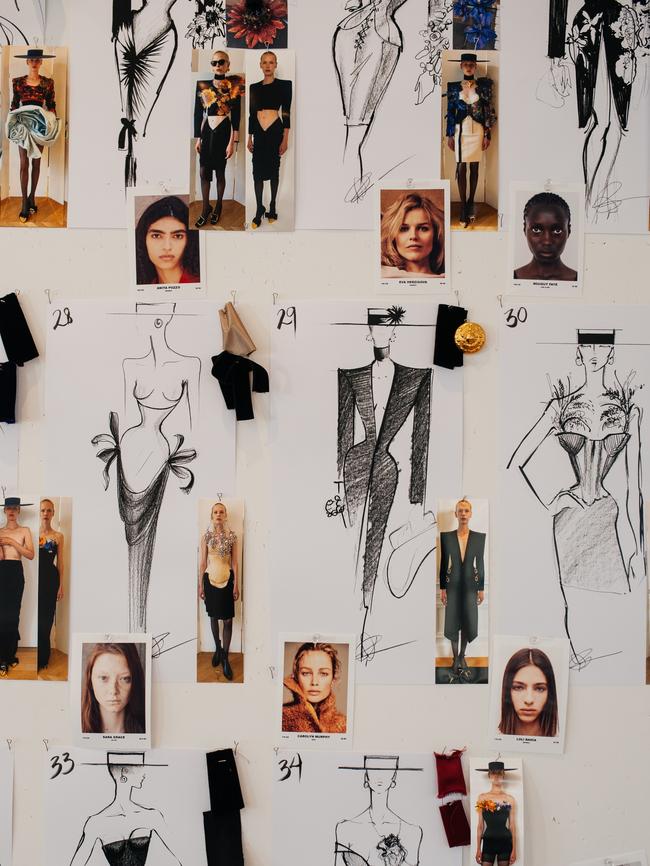
Roseberry hasn’t read Elsa Schiaparelli’s autobiography. She doesn’t haunt him. As Roseberry says, he’s not opening that door. “I hope she’s okay with that. I don’t feel that connection. I feel an intense creative connection with her, but as a person it’s much less complicated to not even go there and I’m not.”
One way he safeguards her legacy is to go beyond the surrealism of the house. As fashion designer Christian Lacroix, one of Roseberry’s influences, said in a conversation with him for Interview magazine earlier this year, it’d be easy to become a prisoner of surrealism in this gig. It is also easy to over-egg surrealism, to take Elsa’s “little jokes” as she called them, too far.
“I think [Schiaparelli] in the wrong hands ... surrealism can become very campy and clichéd and very annoying,” says Roseberry. “Elsa’s work was so much bigger than surrealism. That was just one part of her world. I’m excited to explore what’s beyond that too … it’s something that’s specific to her, but that’s not the only thing. We have such potential and so much demand for the ready-to-wear that it’s also thrilling to be able to meet that demand.”
Still, he says it’s weird and, yes, surreal to see his work in a museum.
One person accustomed to seeing his work as art is Roseberry’s mum. “I’ll give her a pair of earrings, and instead of wearing them she’s taking a painting down in the dining room and they’re hung on the wall and I’m like, dying,” he says, smiling. “She has a mannequin near the kitchen wearing a blouse and I’m like, “This is so not the point!”
Both of his parents were at his couture show in July. “My dad is very emotionally present and was tearing up the whole day and really shook to the core. My mum, I think it’s almost too much for her to process in the moment. My mum and I are so connected as artists because she taught me how to draw. I think she sees a lot of herself and the potential that she had that she gave to me as a mum instead of pursuing it for herself. It’s much more complicated [for Mum].”
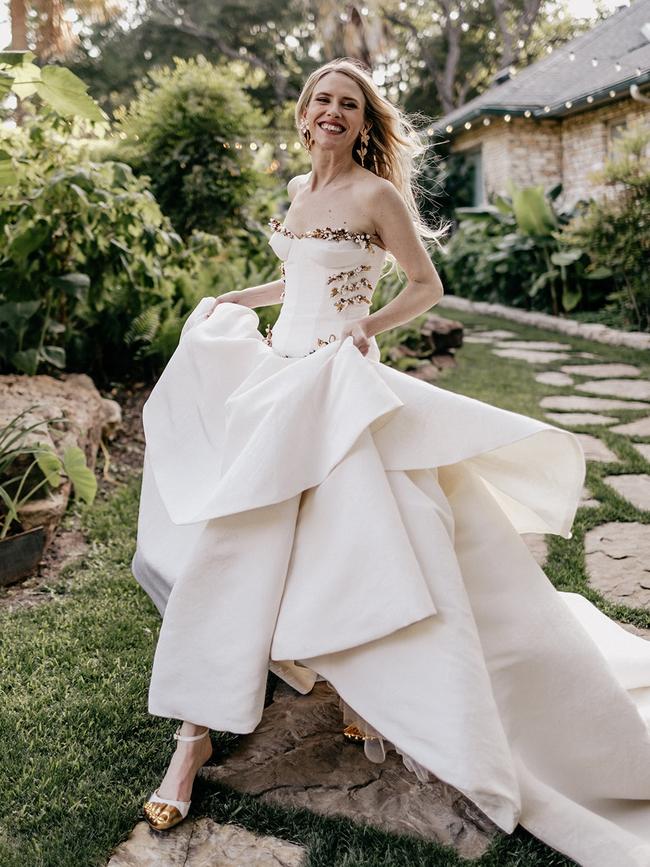
New areas for the maison include bridal. Roseberry launched the concept earlier this year with a dress he created for his sister, Liz Fox Roseberry, to wear on her wedding day. The photos were published in Vogue. She radiated. “She’s never looked so comfortable,” he says. “I’ve never seen her in a corseted gown before. She wore it like a T-shirt. She was just so at ease with it. I loved being able to give that to her.”
Just 48 hours after the couture show, Roseberry had to provide sketches for ways the collection could be interpreted for a bride.
Much has been made of him being an American in Paris – the first American to helm an established couture brand. So is he the quintessential American in Paris? “It’s a myth!” he exclaims. “It’s a complete myth. No, it’s not a complete myth, but you have to learn the language. It’s my own fault that I haven’t.”
As Roseberry puts it, learning French, which he is, or indeed learning anything new and especially as an adult, “making the leap to have the confidence to sound like an idiot is a different thing”.
Still, he likes using a translator in the atelier because it allows for pauses and an understanding on a different level.
“[It] gives us a minute to digest each other’s sentences. It means you really communicate through the work,” he says. “It’s great. Sometimes it’s frustrating [not] to be able to connect emotionally with them.”
Dallas, where he grew up, still feels like home. New York too, he says, will always have a part of him. In Paris there’s the work, and the start of things.
“I feel very, very creatively fulfilled. I think the only thing that’s missing from my life here is meeting a community of people who can make it feel more like home.

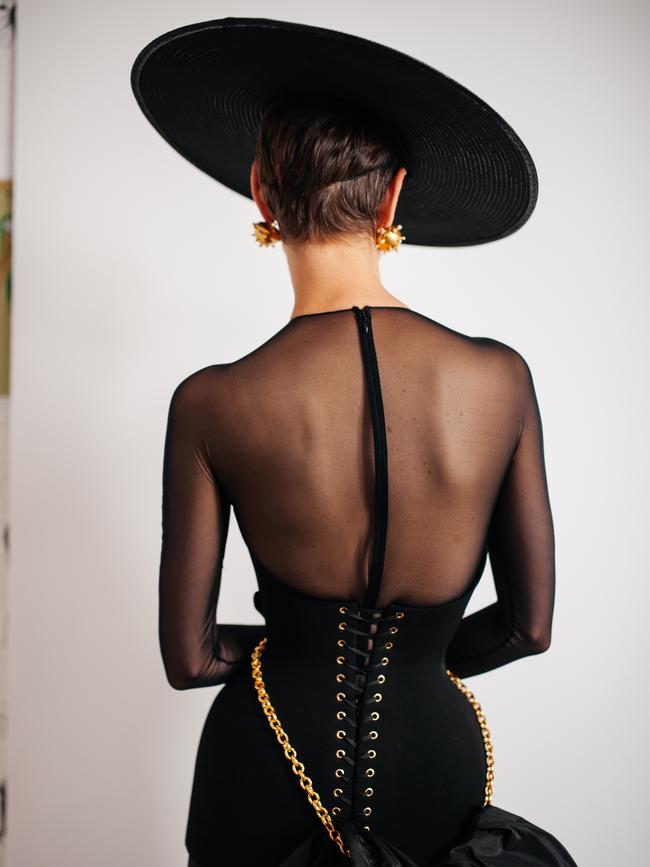
“It’s one thing for Frenchies to not speak French, to speak English at work, but asking Frenchies to speak English at a dinner party is … by dessert, it’s impossible. If they have a few glasses of wine the English goes out the window and then you’re just sitting at the table wondering why you came.”
Roseberry’s father is an Anglican priest and it’s a calling his son considered before he chose fashion school in New York. He gives out an air of being accustomed to talking to all kinds of people from all kinds of places. His great friend, the author and editor Hanya Yanagihara, whose latest bestselling book To Paradise is dedicated to Roseberry, says it isn’t surprising that he almost entered the priesthood.
“I know Daniel’s talked before about how he almost entered the priesthood, and I think all of his friends can see how that would’ve been possible for him, and how good at it he would’ve been,” she says.
“I am constantly amazed by the breadth and depth of Daniel’s imagination and vision – his recent show [haute couture Fall 2022] was almost unsettling for me: how did the person I know and talk to every night imagine all this?! – but what I marvel at most is how wise and thoughtful he is, how much he’s thought about what it means to be a loving person, how psychologically astute he is, how comfortable he is with being vulnerable, how much he pays attention to his friends’ anxieties and concerns.”
Roseberry’s qualities, says Yanagihara, “the attention to details, the willingness to be vulnerable, the lack of cynicism and irony, the depth of empathy”, can be seen in his work too, and are uncommon. “They are rare qualities in a person and in a creative person as well, and I feel very lucky to be the recipient of so much of his time and thoughtfulness.”
Someone important to him once told Roseberry that dreams are expensive. But is it worth it? “God, I think so. I don’t know if I’ll know for sure until like in 20 years. It comes at a huge cost. I just feel you have to walk through the doors that are open to you in life and this door is just open, so here we are. I think that it is worth it. I think it is.”



To join the conversation, please log in. Don't have an account? Register
Join the conversation, you are commenting as Logout